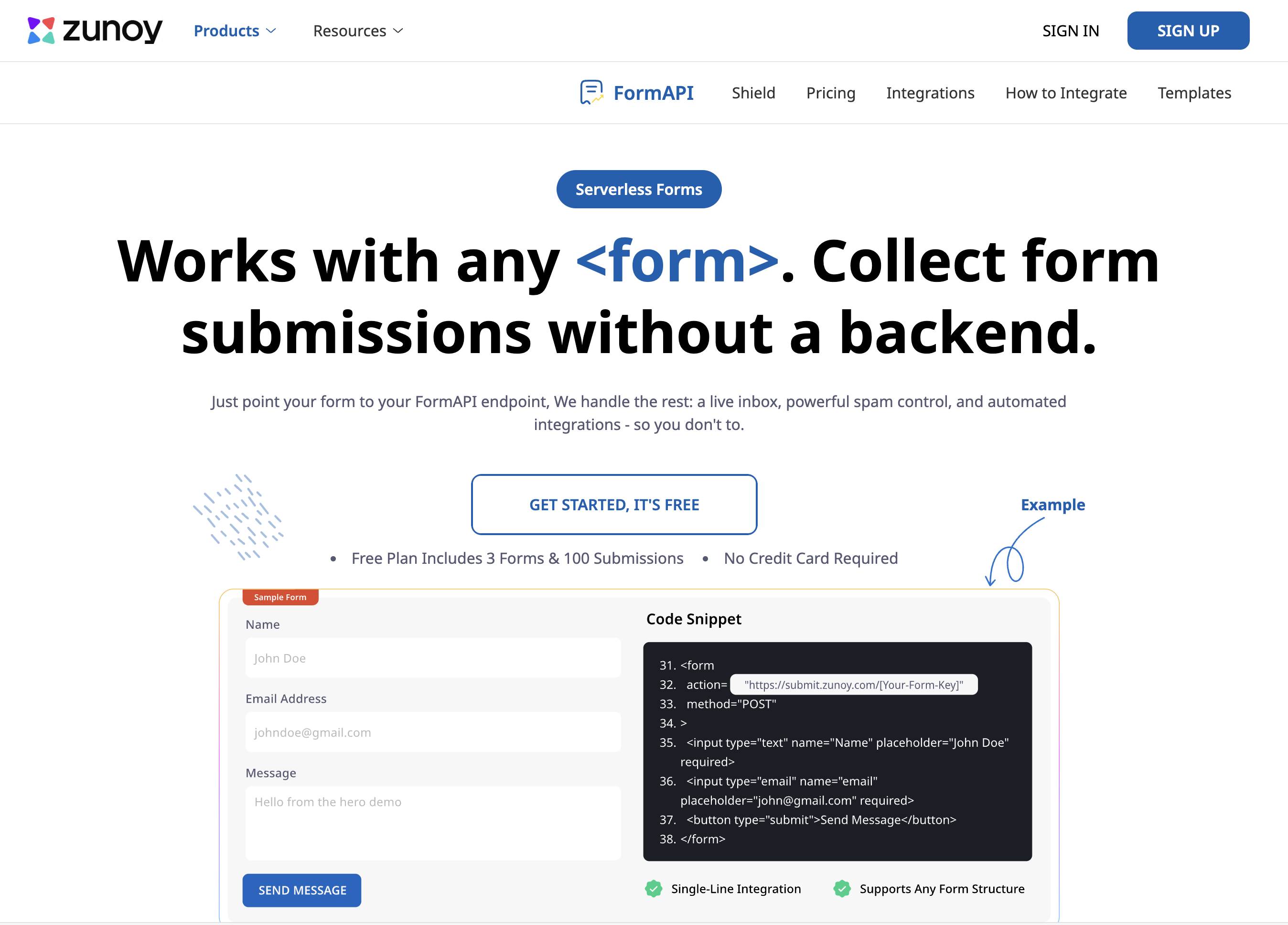Introduction
Web forms are the lifeline of modern websites. Whether it’s a contact form, a newsletter signup, or a feedback survey, forms allow you to connect with visitors and collect valuable information.
But here’s the challenge: what if you don’t have a backend?
For many freelance designers, web developers, and small business owners, setting up a backend server for form handling feels like overkill. You just want an easy way to capture form data without writing PHP, Node.js, or Python code.
The good news is—you absolutely can. Today, we’ll walk through step-by-step methods to capture form submissions without backend code, compare tools, and highlight why a solution like Zunoy FormAPI is one of the most practical and reliable ways to do it.
By the end of this guide, you’ll know exactly how to:
- Capture form submissions without building a server
- Choose between different backend-less form solutions
- Set up and integrate a form API into your website
- Secure your form data and route it to your email, Google Sheets, or apps
Why Capture Form Submissions Without a Backend?
Traditionally, form handling requires:
- Writing server-side code (PHP, Node.js, Python, etc.)
- Configuring databases to store submissions
- Setting up email servers for notifications
- Managing hosting, scaling, and maintenance
For small websites or projects, that’s unnecessary complexity. Instead, backend-less form handling offers:
- Simplicity: Add one line of code and start collecting data.
- No hosting burden: No servers, no maintenance.
- Scalability: Handle thousands of submissions without worrying about infrastructure.
- Integrations: Send data directly to email, Slack, or Google Sheets.
This approach is perfect for:
- Static sites built with HTML/CSS
- Jamstack projects hosted on Vercel, Netlify, or GitHub Pages
- Landing pages built with Webflow, Framer, or Carrd
- Portfolio websites and client projects
How Does It Work?
At the core, the idea is simple:
- Your form submits to a Form API endpoint.
- The API receives the submission.
- The API then stores, forwards, or integrates the data.
No server. No backend code. Just HTML and an endpoint.
Step-by-Step Guide: Capturing Form Submissions Without a Backend
Let’s break this down into practical methods, so you can pick the one that best fits your needs.
Step 1: Create a Basic HTML Form
Here’s a simple form you might use on your site:
<form action="https://submit.zunoy.com/sub/xxxxxx" method="POST">
<label for="name">Name:</label>
<input type="text" id="name" name="name" required>
<label for="email">Email:</label>
<input type="email" id="email" name="email" required>
<label for="message">Message:</label>
<textarea id="message" name="message" required></textarea>
<button type="submit">Send</button>
</form>
With just this snippet, your form data is routed through a Form API instead of a custom backend.
Step 2: Choose a Form Handling Method
There are multiple ways to handle backend-less form submissions. Let’s compare them.
Option A: Use a Form API (Recommended)

Form APIs like Zunoy FormAPI are purpose-built for this.
- Instant setup (just replace the action URL).
- Automatic spam protection.
- Built-in integrations (email, Google Sheets, Slack).
- Reliable delivery and storage.
Option B: Use Static Site Hosting Integrations
Platforms like Netlify Forms or Vercel Edge Functions offer form capture features.
- Pros: Built-in if you’re already on those platforms.
- Cons: Tied to one hosting provider, limited flexibility.
Option C: Use Google Forms as a Backend
Embed a Google Form or route submissions to a Google Sheet.
- Pros: Free, easy.
- Cons: Poor customization, limited branding, harder to integrate.
Option D: Custom Serverless Functions
Use AWS Lambda, Firebase Functions, or Cloudflare Workers.
- Pros: Flexible and powerful.
- Cons: Requires setup, coding, and maintenance.
Comparison Table
Method | Ease of Setup | Flexibility | Integrations | Maintenance |
|---|---|---|---|---|
Zunoy FormAPI | ⭐⭐⭐⭐⭐ | ⭐⭐⭐⭐ | ⭐⭐⭐⭐⭐ | Low |
Netlify/Vercel Forms | ⭐⭐⭐⭐ | ⭐⭐⭐ | ⭐⭐ | Medium |
Google Forms/Sheets | ⭐⭐⭐⭐ | ⭐ | ⭐⭐⭐ | Low |
Serverless Functions | ⭐⭐ | ⭐⭐⭐⭐⭐ | ⭐⭐⭐⭐ | High |
✅ For most small to medium projects, Form API is the sweet spot—easy setup, flexible, and highly scalable.
Step 3: Set Up Your Form API
With Zunoy FormAPI, setup is straightforward:
- Create an account on Zunoy.
- Generate an endpoint URL.
Example:https://zunoy.com/formapi/xyz123 - Replace your form’s
actionattribute with that URL. - Test the form by submitting a sample entry.
You’ll instantly see submissions in your Zunoy dashboard and can route them to:
- Email notifications
- Slack or Microsoft Teams
- Custom Webhooks
Step 4: Secure Your Form Submissions
Even without a backend, security is critical. Here’s how:
- Enable reCAPTCHA or hCaptcha for spam protection.
- Use HTTPS to encrypt submissions.
- Limit allowed domains in your form API settings.
- Validate fields (like email format) in your HTML.
Zunoy FormAPI includes built-in spam filters and domain whitelisting for added protection.
Step 5: Add Advanced Features
Once the basics are working, you can enhance your form with:
- File uploads (CVs, images, documents).
- Auto-responders (thank you emails).
- Multi-step forms for surveys.
- Conditional logic (show/hide fields).
Most of these can be achieved by combining HTML/JS with your Form API.
Real-World Examples
- Freelance Portfolio Website
- Contact form routed through Zunoy FormAPI → email.
- No backend, no maintenance.
- Startup Landing Page
- Signup form sends submissions to Google Sheets + Slack.
- Perfect for investor/demo signups.
- Small Business Website
- Feedback form with file upload.
- Submissions stored securely in dashboard + emailed to support team.
Summary
Capturing form submissions without a backend is no longer a challenge. With tools like Zunoy FormAPI:
- You skip the complexity of building a server.
- Submissions are secure, reliable, and scalable.
- Integrations make data instantly useful.
Instead of worrying about PHP scripts, email servers, or databases, you can focus on building great websites.
Call to Action
👉 Ready to try it yourself? Get started with Zunoy FormAPI today and start capturing form submissions without writing a single line of backend code.
And if you found this guide helpful, share it with other developers or small business owners who struggle with form handling—because no one should have to fight with backend setup just to collect a contact form.
